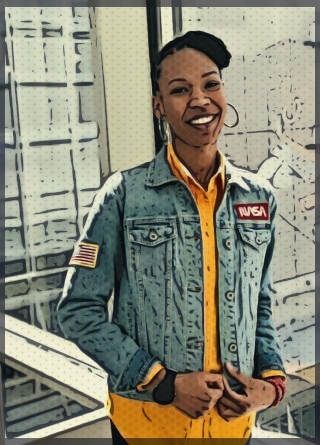In celebration of Introduce a Girl to Engineering Day, we spoke to NASA aerospace engineer, Sabrina Thompson. Sabrina designs orbits for unmanned rovers, meaning she creates the trajectory for their exploration. In addition, Sabrina is a scientist and artist at heart and uses her passions to inspire innovation. For more information about Sabrina and her work, check out her online platform at https://launchpadinspires.com/sabrinas-bio.
In our interview with Thompson, we discuss her inspiration for becoming an Aerospace Engineer, the impact of her work and her advice for young girls who might not know how fun it can be to learn about and work on space-related projects.
Where did your interest in aerospace come from?
RSG: Where did you interest in aerospace come from?
ST: I stumbled upon this path to aerospace engineering. When I was in elementary school, all I thought about was art. I loved drawing as early as I can recall. I remember being in kindergarten, and I would draw the Ninja Turtles and Bart Simpson, and I couldn’t figure out why everyone else was drawing stick figures. I think from a very young age, I just had a creative and curious spirit. I remember asking a lot of questions and having this love for learning.
Once I was in high school, I was still doing art, and I didn’t know about engineering at all until my high school art teacher introduced it to me, or at least told me to give it a shot. And that’s really what started everything. I ended up not being sure what type of engineer I wanted to be, so I majored in mechanical engineering when I went to college the first time for my undergraduate degree. And then I thought, “Well, I wanna work on things that are more complex.” And in my youthful mind, more complex meant spacecrafts instead.
RSG: I love the way your mind works!
ST: Yeah, so I said, “Okay, well, what’s the place that’s known for dealing with spacecraft?” And I thought, “Oh, NASA.” But up until that point, I knew nothing. I just knew of NASA, but I knew nothing about really what type of work was done there. And so from there, I went to graduate school at Georgia Tech and majored in aerospace engineering. And that’s how it started.
What do you think your art teacher saw when she told you to consider engineering?
RSG: It’s interesting that your art teacher told you to consider engineering. What do you think she saw? What prompted her to do that?
ST: She knew I was a pretty smart kid; I actually graduated high school as a valedictorian. She knew I was good at math, and she knew I was good at science. She just put those three things together, you know -math, science, and creativity.
RSG: That’s awesome. From a child’s perspective, Aerospace engineering is sort of abstract. What did the projects and labs look like in College?
ST: So coding, lots of coding, lots of math; of course lots physics and teamwork. At least at the graduate level and just in general, with engineering, you don’t solve problems by yourself. Typically you’re a part of a team, so that’s really important being able to work with others well. I think I learned how to do that over time. I don’t think that was something that was natural for me as an expert.
What do you do now, and why does it matter?
ST: Why does it matter? That’s a good question. Right now, I design orbits and trajectories for NASA missions that are not manned, so they don’t have astronauts on board. We do a lot of testing and simulations on the ground before it goes up to space. Why is it important? Just recently, like last summer, I actually went back to school again, and finished the degree in atmospheric physics, because, to me, it was important to help the scientists to get their instruments up to space and into orbit. But I wanted to know why. I wanted to know why we were putting things in space? Why are we focusing on this whole climate change stuff from space?
For me, it became important to dabble into the science to answer or to help to understand the why. For instance, the focus of a lot of my work today is on coming up with constellations. You could think of it like hives of spacecraft, working together, to make observations about Earth that’ll help us answer some of these really pressing climate change questions that we have. What if we learn more about how the clouds and how pollution and how all these things are really affecting climate change? Then maybe there’s something we could do to mitigate it, or maybe we’ll just learn something about the cycle. That’s just one particular area, but that question can be answered in so many ways.
RSG: That’s actually really fascinating to think about what insight the data we get from going out to space can give us.
What is the most interesting thing you've learned about the Earth through your work?
RSG: What is the most interesting or fascinating thing you’ve learned about the Earth through your work that you didn’t know before?
ST: I didn’t know how clueless we were about something we look up all the time and see. But there’s so much information and knowledge just in how clouds work, and without clouds, what that will do to our ecosystem and how everything functions on earth.
RSG: So very quickly, how important are clouds?
ST: Clouds can do one of two things. They can soak up the sun that comes into the Earth. If you’re beneath the clouds, it is not as hot as it could be if you didn’t have clouds, so that’s one thing. It could just reflect some of that radiation, or the sunlight, back into space, if you will. It could also hide the sun from us. If it’s certain types of clouds, sometimes they could totally block the sun from reaching us on the surface of the earth. You need this balance. If you have too much of one type of cloud and not enough of another, it could totally throw us off balance. And I think that, as far as weather wise, what happens, we’re all balanced, and the Earth’s going to do what it has to do to get back in balance, whether it involves us being here or not.
RSG: That’s really interesting, because like you said, there are many facets of our everyday life we take for granted – clouds being one, rain, the sun, you know, all these things we think are there and will always be there.
What is your favorite activity to do with young kids that helps them open up their minds to aerospace engineering?
RSG: What is your favorite activity to do with young kids that helps them open up their minds to aerospace engineering? If you have one, what’s a good way to explore, in a kid-friendly way?
ST: I’ll just tell you a short story to answer this question. So with NASA, when I started out, knowing all the people who helped me get to where I am today, outreach was huge. It was something that was very important to me. As soon as I could, I figured out a way to join different NASA groups that were doing outreach. I still do to this day. In addition to that, I started to see different trends. And one of the things I noticed was lots of times in certain schools, you had kids, especially boys, who were totally interested in this stuff; they asked the most questions. And then you went into maybe some of the urban schools, and these kids didn’t really know what type of questions to ask. You’re talking over their heads. And they’re like, “Okay, thank you?”
So, I took it upon myself and just started making art that really inspires girls to just go after their dreams. I started this program in 2019 called Stimulating Art, and I teach kids STEM concepts through art projects. It’s my way of seeing a problem and really just kind of doing something about it and not waiting on somebody else to do it. It just felt like I was in a position to do it. So why not?
RSG: We lose a lot of girls, because STEM is not contextualized in a way that brings it into real life and answers the question, “Why should we care?” So how do you do this with art? Give me an example of a project with art that you would do with girls in your program.
ST: It’s a free program, so I have different projects. One of the projects is offered for free on this platform I built. Essentially, it’s designing an astronaut shoe for space exploration, so you take them through the process of learning Newton’s Laws. They learn about Newton’s Laws in a way that is relatable. I introduce dancing; everybody knows Michael Jackson. He had this famous move, whether it’s the moonwalk or the smooth criminal lean, so I use this and teach them the concepts of Newton’s Law and just motion. Then I give them requirements, like to design your own shoe, but it can’t be regular shoes you use, because now we’re on the lunar surface. You have to help the astronauts move about on the lunar surface, which has a different gravity than on Earth. So, you have to figure out what laws are used or defined in your creation of a shoe. I have them present it, and they talk about it. They don’t have to worry about how the shoe would work and all this other stuff – just use your imagination and the laws.
RSG: I love that; that is a brilliant idea!
What would you say to your fifth grade self, knowing what you know now?
RSG: So to wrap up, what would you say to your fifth grade self, knowing what you know now? You had no idea that this is where you were going to land with your art skills and your math and science. What would you tell that little girl?
ST: I would tell that little girl not to worry about fitting in. Sometimes you don’t fit in for a reason. Especially as a fifth grader, you’re at that age where you’re going into middle school or you’re starting middle school, and there’s peer pressure and your bodies change. You’re going through all these things that make you so insecure. And I think just knowing it’s going to be okay, and it’s okay to be a little odd.
RSG: I love that message for young girls to just prepare their minds for those moments in their lives where they’re going to feel somewhat awkward and different and to use that to their advantage!

